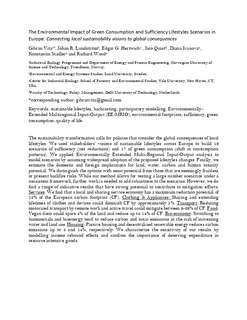| dc.contributor.author | Vita, Gibran | |
| dc.contributor.author | Lundström, Johan R. | |
| dc.contributor.author | Hertwich, Edgar G. | |
| dc.contributor.author | Quist, Jaco | |
| dc.contributor.author | Ivanova, Diana | |
| dc.contributor.author | Stadler, Konstantin | |
| dc.contributor.author | Wood, Richard | |
| dc.date.accessioned | 2019-11-22T10:22:45Z | |
| dc.date.available | 2019-11-22T10:22:45Z | |
| dc.date.created | 2019-07-26T17:34:46Z | |
| dc.date.issued | 2019 | |
| dc.identifier.citation | Ecological Economics. 2019, 164 . | nb_NO |
| dc.identifier.issn | 0921-8009 | |
| dc.identifier.uri | http://hdl.handle.net/11250/2630035 | |
| dc.description.abstract | The sustainability transformation calls for policies that consider the global consequences of local lifestyles. We used stakeholders' visions of sustainable lifestyles across Europe to build 19 scenarios of sufficiency (net reductions) and 17 of green consumption (shift in consumption patterns). We applied Environmentally Extended Multi-Regional Input-Output analysis to model scenarios by assuming widespread adoption of the proposed lifestyles changes. Finally, we estimated the domestic and foreign implications for land, water, carbon and human toxicity potential. We distinguish the options with most potential from those that are seemingly fruitless or present backfire risks. While our method allows for testing a large number scenarios under a consistent framework, further work is needed to add robustness to the scenarios. However, we do find a range of indicative results that have strong potential to contribute to mitigation efforts. Services: We find that a local and sharing service economy has a maximum reduction potential of 18% of the European carbon footprint (CF). Clothing & Appliances: Sharing and extending lifetimes of clothes and devices could diminish CF by approximately 3%. Transport: Reducing motorized transport by remote work and active travel could mitigate between 9 and 26% of CF. Food: Vegan diets could spare 4% of the land and reduce up to 14% of CF. Bio-economy: Switching to biomaterials and bioenergy tend to reduce carbon and toxic emissions at the risk of increasing water and land use. Housing: Passive housing and decentralized renewable energy reduces carbon emissions up to 5 and 14%, respectively. We characterize the sensitivity of our results by modelling income rebound effects and confirm the importance of deterring expenditure in resource intensive goods. | nb_NO |
| dc.language.iso | eng | nb_NO |
| dc.publisher | Elsevier | nb_NO |
| dc.rights | Attribution-NonCommercial-NoDerivatives 4.0 Internasjonal | * |
| dc.rights.uri | http://creativecommons.org/licenses/by-nc-nd/4.0/deed.no | * |
| dc.title | The Environmental Impact of Green Consumption and Sufficiency Lifestyles Scenarios in Europe: Connecting Local Sustainability Visions to Global Consequences | nb_NO |
| dc.type | Journal article | nb_NO |
| dc.type | Peer reviewed | nb_NO |
| dc.description.version | acceptedVersion | nb_NO |
| dc.source.pagenumber | 16 | nb_NO |
| dc.source.volume | 164 | nb_NO |
| dc.source.journal | Ecological Economics | nb_NO |
| dc.identifier.doi | 10.1016/j.ecolecon.2019.05.002 | |
| dc.identifier.cristin | 1712926 | |
| dc.description.localcode | © 2019. This is the authors’ accepted and refereed manuscript to the article. Locked until 27.6.2021 due to copyright restrictions. This manuscript version is made available under the CC-BY-NC-ND 4.0 license http://creativecommons.org/licenses/by-nc-nd/4.0/ | nb_NO |
| cristin.unitcode | 194,64,25,0 | |
| cristin.unitname | Institutt for energi- og prosessteknikk | |
| cristin.ispublished | true | |
| cristin.fulltext | postprint | |
| cristin.qualitycode | 1 | |

